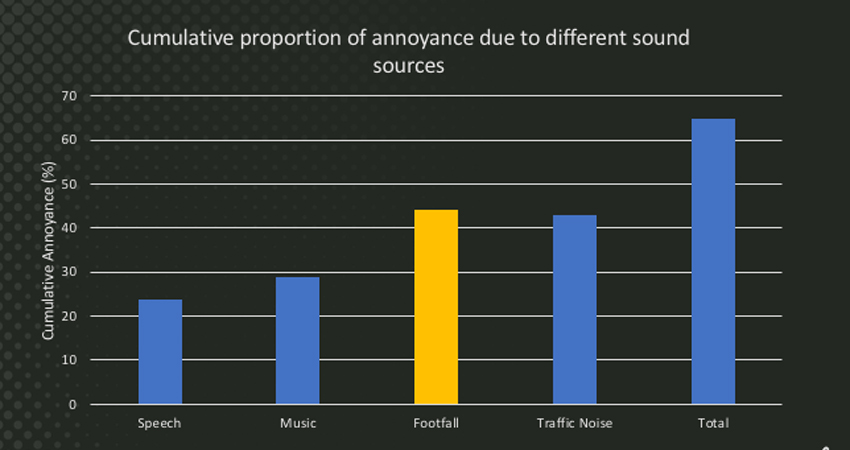Secondhand Noise: Can Flooring Solve the Problem?
Where Noise is Especially Troublesome
So, with all of these guidelines, all of these standards, all of these people working on them, how are we doing?
“Maybe not so great,” says acoustic expert Mike Raley, who now works in-house for a flooring manufacturer. He points to the indoor environments where noise is especially troublesome: hospitals, green buildings, and housing.
Noise in Hospitals
Noise problems in hospitals have been studied at great length, including widespread surveys of patient satisfaction in hospitals, as indicated by the Hospital Consumer Assessment of Healthcare Providers and Systems (HCAHPS) data. HCAHPS (commonly pronounced H-caps) is a national, standardized, publicly reported survey of patients’ perspectives of hospital care.
One of the questions in the HCAHPS survey asks about noise, and specifically about how quiet the hospital was at night. Since the HCAHPS survey began, the noise at night question has been the lowest or second lowest scoring category in terms of patient satisfaction. In other words, patients are not satisfied. That dissatisfaction on the survey can hurt hospitals financially, as low scores can cause funds to be withheld by the Centers for Medicare & Medicaid Services (CMS).
This is not new knowledge. Florence Nightingale, who is considered to be the mother of modern nursing, wrote in the mid-1800s a book titled Notes on Nursing that states, “Unnecessary noise is the most cruel abuse of care which can be inflicted on either the sick or the well.”
“Though we have been working on this problem for a long time, it does not seem to be getting much better overall,” Raley says.
Green Buildings
Over the past few decades, there has been a focus on “green” buildings. As a result, we now see these improvements: higher energy efficiency, improved indoor environments, reduced toxins, added natural light, biophilic design, and other occupant-focused design strategies. But, according to studies, the satisfaction with the acoustics in green buildings is actually lower than it is in the non-green buildings.4 “As design trends have moved to harder surfaces and more open-plan office environments, we have actually degraded the acoustics rather than improved them,” Raley says.
Housing
Housing is another area that needs acoustical help, with footfall noise from neighbors being cited as a major health hazard and not just an annoyance. A paper titled “Health effects of annoyance induced by neighbour noise” that was published in Noise Control Engineering Journal states, “Neighbour noise induced annoyance is… a highly underestimated risk factor for healthy housing.”5
The chart above shows the cumulative proportion of annoyance due to different sound sources in a study that looked at sound quality in dwellings located in Norway. Footfall had a higher cumulative annoyance than did traffic noise.6
So, considering all situations in which noise is a health hazard, these questions arise: Why are our efforts with testing and standards not working? Are we testing and measuring what we really care about? It appears that common sound measurements do not really measure the human experience. It could be that acceptable amounts of noise transmission, according to the building code, is actually not acceptable when the goal is human health and well-being. To understand why more noise-control measures should be considered, particularly in flooring, it is important to understand noise itself.

Footfall noise from neighbors can generate a high level of annoyance.
Understanding Noise
To design a building that does not create excess noise, and thus excess stress and diminished health for occupants, it helps for the architect, designer, or specifier to understand how sound works, how it moves through a building, and how it can be stopped.
What actually makes a sound a noise? Think about a marching band of bagpipes. This might be music to some people’s ears, but maybe not for everyone. Sound versus noise is in the ear of the beholder. Both acoustic factors and non-acoustic factors affect whether or not someone might consider a sound to be a noise.
Acoustic Factors
Acoustic factors include the following:
Frequency content: Consider white noise used as masking noise to help people sleep. This has a broad frequency range. But an alarm, such as a backup beeper on a big truck, uses a narrow frequency range. This is specifically meant to be annoying and grab your attention.
Loudness: This is a whisper versus yelling issue. Something that is loud is more likely to be disruptive and considered annoying than something less loud.
Duration: A sound that goes on for a long time is more likely to annoy people than a sound that is short lived.
Occurrence rate: How often are there loud sounds? Is the soundscape fairly smooth without many changes? Or are there a lot of short-duration sounds, with alarms and beeps going off, someone talking over here, and someone talking over there? This drop, this bang, this clang? If it is fairly consistent, it is easier for people to adjust to it and tune it out. But if the noise is always changing, with spikes and low points, it is much harder to tune it out.

Both acoustic and non-acoustic factors contribute to turning a sound into unwanted noise.
Non-Acoustic Factors
Non-acoustic factors include the following:
Control: If it is a sound that people control, it is probably less likely to be annoying than a sound they do not control.
Attitude toward the source of the sound: How people feel about the source of the sound plays a part in its annoyance level. If a person lives in an apartment adjacent to a neighbor they have bad relations with, any sound that neighbor makes will be considered noise. But if an occupant has good relations with an adjacent neighbor, the occupant will be more tolerant of any sound the neighbor makes. As a measure to control annoying sounds, this strategy is sure to fail, as relations can change quickly.
Predictability: If the sound is predictable, if an occupant knows it is coming, such as the 6 o’clock train, the sound can be prepared for, and it causes less annoyance. But if a sound is less predictable and is not expected, then it cannot be prepared for, and it is more likely to be annoying.
IIC Ratings for Floor/Ceiling Assemblies Measure Quantity, Not Quality
Understanding that human perceptions cause a sound to become a noise is important when specifying flooring and other products to reduce sound. From a building-code perspective, the tendency may be to reach the minimum ratings necessary and leave it at that. But ratings measure the quantity of sound, not the quality of sound.
Consider the IIC ratings for floor/ceiling assemblies. Most codes call for a minimum IIC rating of 50. This rating is typically achieved in a laboratory test using a tapping machine on the floor above and then measuring the sound reaching the room below. This is the quantity of sound. But the quality of sound may include many of the factors discussed above, including frequency, duration, predictability, etc.
A higher IIC rating than is required by code helps cut down on unwanted sound inside a building, a function that is not reliant on perceptions. Less sound transmission means less annoyance, and this means better health for the occupants.
Two assemblies that have the same IIC rating can still sound markedly different. For instance, in wood-framed construction, low-frequency thumps and thuds from footsteps are very noticeable, even with plush carpet and padding for the flooring, but in heavy concrete construction, thumps and thuds generally are not noticeable. Ultimately, single-number ratings like the IIC do not fully describe the quality of the sound, and they therefore limit the ability to design spaces that minimize the adverse effects of noise.









